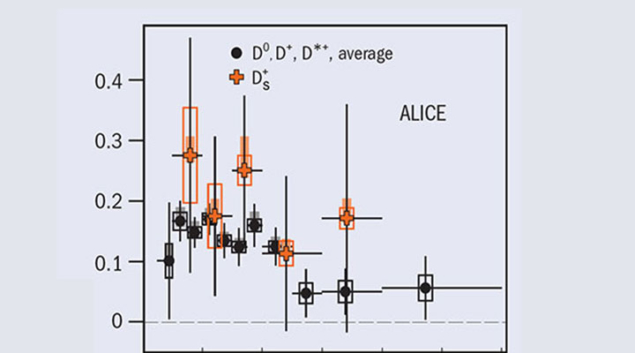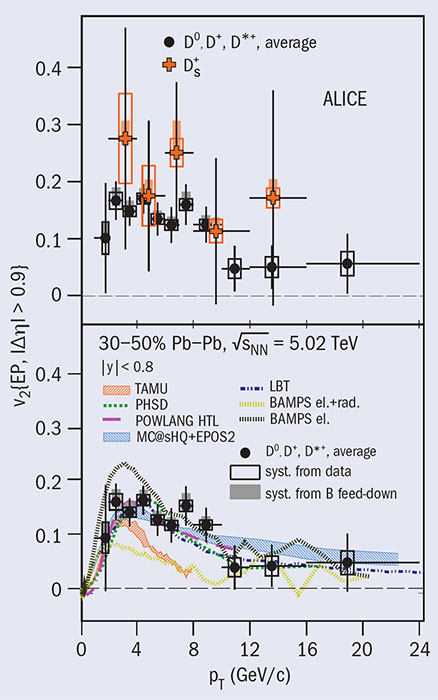

The ALICE collaboration has reported a measurement of the azimuthal anisotropy in the production of D mesons, which contain a charm quark, when measured relative to the estimated reaction plane of lead–lead collisions at 5.02 TeV at LHC Run 2. The new measurement is a factor two more precise than the Run 1 measurement and clearly indicates that charm takes part in the collective flow of the colour-deconfined quark–gluon plasma (QGP).

Since heavy quarks are produced in hard-scattering processes on a timescale shorter than the QGP formation time, they experience all stages of the system’s evolution. Evidence of interactions between charm quarks and the medium is provided by the observed strong modification of the transverse momentum (pT) distribution of D mesons in heavy-ion collisions with respect to pp collisions. This is understood in terms of elastic scatterings and gluon-radiation in the medium. Measurements of anisotropies in the azimuthal distribution of heavy-flavour hadrons provide further information to determine the transport properties of the medium. The QGP expansion converts the initial spatial anisotropy, which originates from the geometry of the collision, into a particle-momentum anisotropy. The elliptic anisotropy is characterised by the second Fourier coefficient (v2) of the particle’s azimuthal angle distribution relative to the estimated reaction plane.
The measurement of v2 for the D meson addresses the issue of whether the flow that is generated by the expansion of the collision system and is known to affect light quarks is also imparted to the much heavier charm quarks. Additionally, hadronisation of charm quarks via recombination with light quarks could contribute to the D-meson flow. This motivates a comparison of the v2 of D mesons with and without strange-quark content.
ALICE measured the v2 of D0, D+, D*+ and, for the first time at the LHC, of D+s mesons in mid-central lead–lead collisions at an energy of 5.02 TeV per nucleon. The average v2 of non-strange D mesons is larger than zero and similar to that of pions, which is compatible with a similar recent measurement by CMS. The D+s v2 was found to be positive and compatible with that of non-strange D mesons (top panel of the figure). The improved precision of the new measurement compared to the Run 1 measurement at an energy of 2.76 TeV per nucleon will significantly improve the determination of the heavy-quark diffusion coefficient in the QGP at LHC, which is one of the fundamental properties of this exotic form of matter.





